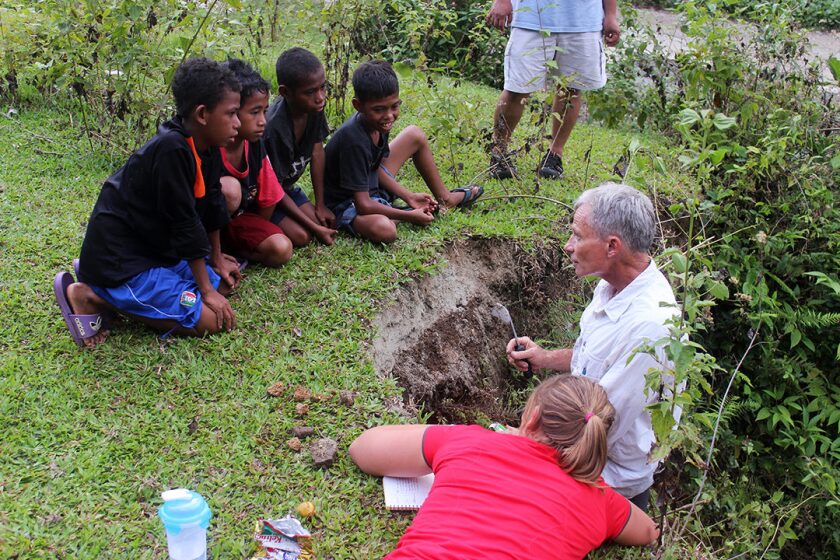
The Indian Ocean tsunami that rocked Indonesia on December 26, 2004, shook the ground beneath the locals’ feet for eight whole minutes. Thirteen years later, Dr. Ron Harris is still shaken.
In the years before the earthquake and ensuing tsunami, Harris had been studying the geological fault lines off the coast of Indonesia, one of the most seismically active locations in the world. Combining geological and historical data from Indonesia’s Dutch colonists, Harris came to a startling conclusion.
“A large earthquake and tsunami were overdue in northern Sumatra,” said Harris.
Harris published his projections in geological journals first in 1997 and again in 2002, but only academics saw his work. And then, two years later, it happened.
“The biggest tsunami ever recorded,” said Harris.
At least 180,000 people died in Indonesia alone from the Indian Ocean tsunami. To this day, Harris wonders what would have happened if he had educated those in coastal communities what tsunami warning signs to be aware of and how to evacuate.
“Instead of 180,000 people dying, probably less than 50,000 people would have died,” said Harris. “I [potentially] could have saved over 130,000 lives. Just by going around and doing that! That’s what got me started.”
While it is impossible to know how many lives proper tsunami preparation could have saved that day, Harris has undergone “a complete 180-degree turn” in his career since 2004.
“Like most scientists, I just thought that [warning people] was somebody else’s job,” said Harris. “But nobody works in that gap [between research and implementation]. I finally realized that. So, I started my own nonprofit organization called In Harm’s Way where I could get funds for doing research in that gap.”
Harris, along with fellow researchers and students, now travels throughout Indonesia preparing residents for future catastrophes. This work began in three phases. First, Harris mapped out areas of the Indonesian fault that were most at risk for seismic events. Armed with this information, Harris and his team of communications, public health, math, and social science experts then developed a concise, convincing message. Finally, Harris and his team personally travelled to the most at-risk villages in Indonesia, drawing localized evacuation routes and running drills for communities in schools, mosques, and churches.
“We spent the last two years going from village to village doing what I should have done before 2004,” said Harris.
While Harris and his team have perfected their message now, their first presentations missed the mark.
“We went into these places where people hardly even had a high school education,” said Harris. “[We] did a survey after our really technical presentation and learned that people essentially didn’t learn anything.”
Harris knew he needed to condense his message. After several discussions with his team, Harris hit on an idea.
“We came up with the best way to warn the people that takes all of this [interdisciplinary] science we’ve done and condenses it into three numbers: ‘20-20-20,’” said Harris.
The phrase “20-20-20” explains the three most important facts that people in tsunami-risk areas need to know in an emergency. If the ground shakes for more than 20 seconds, that means you have 20 minutes to get to an elevation of at least 20 meters. (Knowing that it only takes 20 seconds of shaking to cause a tsunami, the eight minutes of rumbling that precipitated the 2004 tsunami comes into frightening perspective.) Harris and Indonesian officials have put the three numbers on t-shirts, scarves, signs, and children’s board games across Indonesia.
“Once I started listening, I found out what the people really needed,” said Harris. “They needed ’20-20-20.’ It’s taken me a long time to get there. But it works.”
“20-20-20” has already proven effective. In 2013, an earthquake caused a landslide which dammed a river and threatened to flood a whole village in Ambon, an island in Indonesia. The local disaster mitigation agency, religious leaders, and other community members came together to run evacuation drills based on the “20-20-20” model. When the dam finally broke, the villagers were familiar enough with the evacuation routes that it only took seven minutes for more than 2,000 people to evacuate. Even though the waves washed away 428 homes, only seven people died.
The event didn’t even make the news—which, to Harris, means it was a success.
But Harris has seen other unexpected successes in this work.
“This one issue brings people from various cultures and religions together to work as a team,” said Harris. “We went into a town that was 50% Christian, 50% Muslim. We would have the Muslim organization in the city set up the presentation in their mosque, and here are the Christians coming in the mosque. This is the first time they have ever been in the mosque and the Muslims are inviting them. They are sitting next to one another and talking.”
“It doesn’t matter what your religion is,” said Harris. “Both religions believe in saving lives and self-reliance, and that’s what this does. The payoffs are already there, as far as I’m concerned.”
Harris is determined to make sure that the “20-20-20” model “takes on a life of its own” and continues in the hands of the locals. Recently, Harris received a message from a town his team visited that showed that “20-20-20” is alive and well in Indonesia.
“There were all these pictures of these people on bikes with ‘20-20-20’ written on cardboard that was . . . painted like a tsunami wave,” said Harris. “They did a tsunami parade. They had a [pretend] earthquake and then 20 minutes later the bikes came through the streets like a tsunami and anybody who they could tag was ‘dead.’ I would have never thought of that!”
“When we got these postings about the ‘20-20-20’ parade that happened all on its own, without us even being here, I thought: There it is,” said Harris. “A life of its own.”